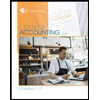
Concept explainers
Prepare the
Explanation of Solution
Common stock:
These are the ordinary shares that a corporation issues to the investors in order to raise funds. In return, the investors receive a share of profit from the profits earned by the corporation in the form of dividend.
Par value:
It refers to the value of a stock that is stated by the corporation’s charter. It is also known as face value of a stock.
Journal:
Journal is the method of recording monetary business transactions in chronological order. It records the debit and credit aspects of each transaction to abide by the double-entry system.
Rules of Debit and Credit:
Following rules are followed for debiting and crediting different accounts while they occur in business transactions:
- Debit, all increase in assets, expenses and dividends, all decrease in liabilities, revenues and stockholders’ equities.
- Credit, all increase in liabilities, revenues, and stockholders’ equities, all decrease in assets, expenses.
Journal entries for given transaction are as follows:
a. Issued 30,000 common shares at $40 per share and issued 5,000 shares of
| Date | Accounts title and explanation | Ref. | Debit ($) | Credit ($) |
| Cash (+A) (6) | 1,330,000 | |||
| Common stock (+SE) (1) | 1,200,000 | |||
| Preferred stock (+SE) (4) | 25,000 | |||
| Additional paid-in capital, preferred stock (+SE) (5) | 105,000 | |||
| (To record issuance of common stock and preferred stock) |
Table (1)
- Cash is an assets account and it increased the value of asset by $1,330,000. Hence, debit the cash account for $1,330,000.
- Common stock is a component of
stockholder’s equity and it increased the value of stockholder’s equity by $1,200,000, Hence, credit the common stock for $1,200,000. - Preferred stock is a component of stockholder’s equity and it increased the value of stockholder’s equity by $25,000. Hence, credit the preferred stock for $25,000.
- Additional paid-in capital, preferred stock is a component of stockholder’s equity and it increased the value of stockholder’s equity by $105,000. Hence, credit the additional paid-in capital, preferred stock account for $105,000.
Working note:
Calculate the value of common stock
Common stock =( Number of share×Par value per share)=30,000 shares×$40=$1,200,000 (1)
Calculate the cash received from common stock
Cash received from common stock=( Number of share×Cash per share)=30,000 shares×$40=$1,200,000 (2)
Calculate the value of preferred stock
Preferred stock =( Number of share×Par value per share)=5,000 shares×$5=$25,000 (3)
Calculate the cash received from preferred stock
Cash received from preferred stock =( Number of share×Cash per share)=5,000 shares×$26=$130,000 (4)
Calculate the value of additional paid in capital, preferred stock
Additional paid-in capital = (Cash received (4)−Preferred stock value (3))=($130,000−$25,000)=$105,000 (5)
Calculate the value of total cash received from preferred stock and common stock
Total cash received = (Cash received from common stock (2)+Cash received from preferred stock (4) )=$1,200,000+$130,000=$1,330,000 (6)
b. Issued 9,000 shares of preferred stock at $20 each:
| Date | Accounts title and explanation | Ref. | Debit ($) | Credit ($) |
| Cash (+A) (8) | 64,000 | |||
| Preferred stock (+SE) (7) | 10,000 | |||
| Additional paid-in capital, preferred stock (+SE) (9) | 54,000 | |||
| (To record the issuance of preferred stock) |
Table (2)
- Cash is an assets account and it increased the value of asset by $64,000. Hence, debit the cash account for $64,000.
- Preferred stock is a component of stockholder’s equity and it increased the value of stockholder’s equity by $10,000. Hence, credit the preferred stock for $10,000.
- Additional paid-in capital, preferred stock is a component of stockholder’s equity and it increased the value of stockholder’s equity by $54,000. Hence, credit the additional paid-in capital, preferred stock account for $54,000.
Working note:
Calculate the value of preferred stock
Preferred stock =( Number of share×Par value per share)=2,000 shares×$5=$10,000 (7)
Calculate the total cash received
Total amount of cash received =( Number of share×Cash per share)=2,000 shares×$32=$64,000 (8)
Calculate the value of additional paid in capital, preferred stock
Additional paid-in capital = (Total cash received (8)−Preferred stock value (7))=($64,000−$10,000)=$54,000 (9)
c. Repurchase of 3,000 common shares at $38 per share:
| Date | Accounts title and explanation | Ref. | Debit ($) | Credit ($) |
| Treasury stock (-SE) (10) | 114,000 | |||
| Cash (-A) | 114,000 | |||
| (To record the repurchase of common shares from investors) |
Table (3)
- Treasury stock is the contra-equity. There is an increase in the contra-equity which decreases the value of stockholders’ equity. Hence, debit the treasury stock with $114,000.
- Cash is an asset. There is a decrease in the asset. Hence, credit cash account with $144,000
Working note:
Calculate the value of repurchase of shares
Total amount of repurchase of shares=( Number of share×Cash per share)=3,000 shares×$38=$114,000 (10)
Want to see more full solutions like this?
Chapter 11 Solutions
Connect Access Card for Financial Accounting
- The Frida Corporation reported total manufacturing costs of $245,000; manufacturing overhead totaling $68,000 and direct materials totaling $57,000. How much is direct labor cost?arrow_forwardI need help with this general accounting question using standard accounting techniques.arrow_forwardI am looking for the correct answer to this financial accounting question with appropriate explanations.arrow_forward
- What is the unit product cost for the year?arrow_forwardFor Bears Company, the predetermined overhead rate is 125% of direct labor cost. During the month, Bears incurred $143,500 in factory labor costs, of which $118,600 is direct labor and $24,900 is indirect labor. The actual overhead incurred was $159,800. Compute the amount of manufacturing overhead applied during the month. Determine the amount of under- or overapplied manufacturing overhead.arrow_forwardHello tutor please given General accounting question answer do fast and properly explain all answerarrow_forward
 College Accounting, Chapters 1-27 (New in Account...AccountingISBN:9781305666160Author:James A. Heintz, Robert W. ParryPublisher:Cengage Learning
College Accounting, Chapters 1-27 (New in Account...AccountingISBN:9781305666160Author:James A. Heintz, Robert W. ParryPublisher:Cengage Learning College Accounting, Chapters 1-27AccountingISBN:9781337794756Author:HEINTZ, James A.Publisher:Cengage Learning,
College Accounting, Chapters 1-27AccountingISBN:9781337794756Author:HEINTZ, James A.Publisher:Cengage Learning, Financial AccountingAccountingISBN:9781337272124Author:Carl Warren, James M. Reeve, Jonathan DuchacPublisher:Cengage Learning
Financial AccountingAccountingISBN:9781337272124Author:Carl Warren, James M. Reeve, Jonathan DuchacPublisher:Cengage Learning Financial And Managerial AccountingAccountingISBN:9781337902663Author:WARREN, Carl S.Publisher:Cengage Learning,Principles of Accounting Volume 1AccountingISBN:9781947172685Author:OpenStaxPublisher:OpenStax College
Financial And Managerial AccountingAccountingISBN:9781337902663Author:WARREN, Carl S.Publisher:Cengage Learning,Principles of Accounting Volume 1AccountingISBN:9781947172685Author:OpenStaxPublisher:OpenStax College Accounting (Text Only)AccountingISBN:9781285743615Author:Carl Warren, James M. Reeve, Jonathan DuchacPublisher:Cengage Learning
Accounting (Text Only)AccountingISBN:9781285743615Author:Carl Warren, James M. Reeve, Jonathan DuchacPublisher:Cengage Learning





